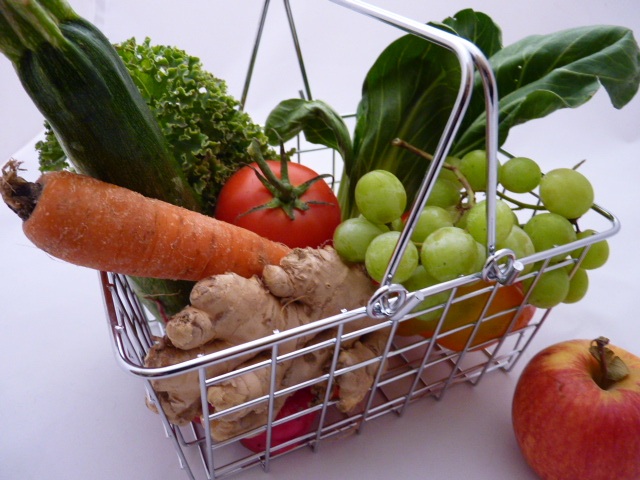Raw Food Diet and Your Budget

“Economic crisis?”
Barring your living in an Appalachian cave or a paid-for Manhattan penthouse, you know there’s a crunch on. Will it last, or will it all go away soon? The pundits may know, but I don’t. (While raw food diet does fuel the intellect, there are limits!)
Fact is, a buck only goes so far, and we all seem to have fewer bucks, or to be guarding more carefully what we do have. For raw foodists and burger-people alike, the food budget is one place we turn to early.
People often presume it costs a lot more to be on the raw food diet. Not so, however, if you take a few precautions. Now’s an ideal time to trim your food budget and build habits to serve you through lean times and large times.
Some tips for developing those habits…
Stay Out Of The Supermarket
Stay out of the supermarket. As much as you can, at any rate. Shop at farmer’s markets. Buy directly from farms, where you can. Buying local produce is a great way to save and be sure you’re getting fresh, truly high-quality foodstuffs. Buy smart. Look for quality. Don’t be afraid to negotiate, and you may gain some significant savings.
Pick Your Own
Pick your own. “U-Pick” is a common feature at farms which sell directly to the public. Pick those berries, pluck those tomatoes today, and you’ll walk away knowing your produce hasn’t languished in supermarket back rooms or tractor-trailers for days on end, losing precious nutrients.
Co-Op
Join a co-op. Bigger cities, even smaller ones in farming areas, sometimes offer the chance to join a co-operative. Bulk items, especially—seeds and nuts, which keep well—are worth stocking up on when they go on sale.
Eat Greens
Eat more greens. Greens, to speak plainly for a moment, are cheap, good food. They’re economical, versatile, surprisingly varied in their nutritional makeup, and represent truly frugal eating. Use them for salads, wraps, juices, smoothies, soups, and as accents in presenting other foods. Leafy greens are nutritional powerhouses, giving you maximum bang for your food buck.
Wild Veggies and Mushrooms
Eat free! No—we’re not suggesting you skip out on your next restaurant tab. Consult a good book. Learn about the many little-known common plants you can find in your area quite free of charge—dandelion, nettles, chickweed, miner's lettuce and purslane are among these “edible weeds.”
Mushrooms, in many parts of the country, offer opportunities not only for good eating, but more than a little fun in the chase. Be dead certain, though, of what you’re picking, or you’ll be certainly dead. (Books can help, as can the mushroom enthusiasts’ organizations found in some cities.)
Wild Berries
Less adventurous, but even more plentiful, depending on your location, are wild berries. Strawberries’ and blueberries’ wild varieties will impress you. More exotic species, such as lingonberries, saskatoons and bramble berries are true delicacies. Check your local continuing education catalogs for courses, and look for guided nature walks that can teach you.
Grow Your Own
Grow your own—the other way to eat free. Once upon a time in suburbia, everyone kept a garden. Now, few bother. You should. Consider: You can grow organic, and know exactly how chemical free your produce is. You don’t need the proverbial hundred a sixty acres full of sunshine—even a few planters and boxes still do. If you do nothing more than plant a few seeds in a few clay pots, you’ll be helping yourself and your wallet.
Eat Twice a Day
Eat just twice a day. Come on—it’s time! Two injections a day is all the food your healthy body really needs. Here, in fact, is one of the most powerful nutritional moves you can make—both health-enhancing and money-saving. Keep your meals simple, the way I describe in my Quantum Eating, and you’ll trim down your grocery cart, your bill, and your body!
Write Your Menu
Write your menu. Stick to it. No, really—WRITE it. Don’t just think it. The idea is: Plan what you’re going to eat, and eat only that. This will stop you from buying extra…from spending too much, and—a bonus for those still transitioning—from cheating. Stick with simple, whole foods. Stay away from pricey items, supplements, unneeded garnishes.
Use Your Leftovers
Use your leftovers. Once you truly go raw, little if anything should go to waste. Use vegetable pulp (left over from making juices, etc.) to make crackers or nut cheeses. Learn. Browse online for new recipes. Make extra juice in the morning, and use it later for soups, as suggested in Rawsome Flex.
Fast Weekly
Fast weekly. Many people on the raw food diet deliberately practice a day of fasting a week. For these folks, it’s fundamental—one of the basics. Try it. Give your body and your budget a break!
It’s the perfect time right now.
Come on—do it … Spring into action!

